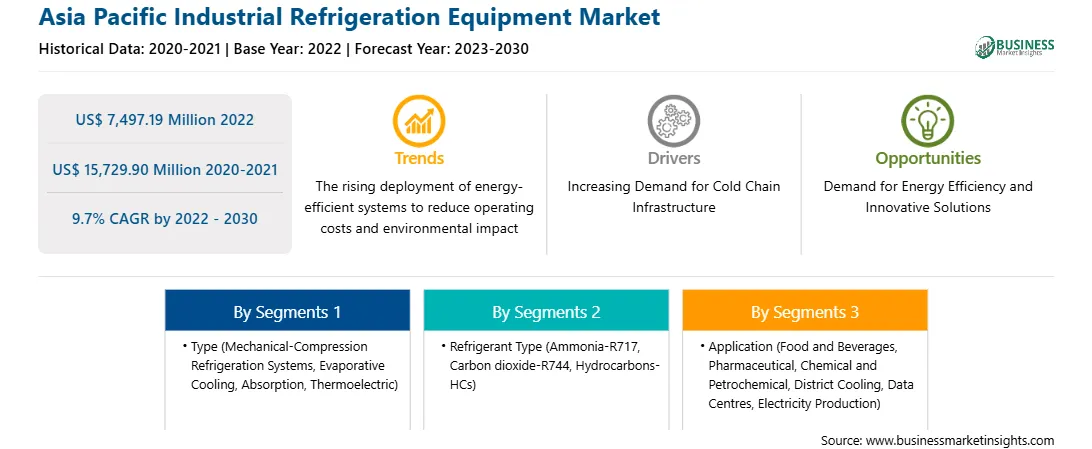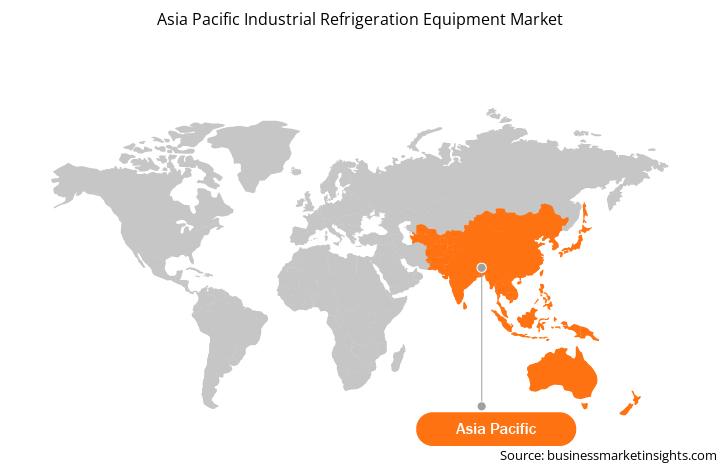Asia Pacific Industrial Refrigeration Equipment Market
No. of Pages: 108 | Report Code: BMIRE00029414 | Category: Electronics and Semiconductor
No. of Pages: 108 | Report Code: BMIRE00029414 | Category: Electronics and Semiconductor
Natural refrigerants are being adopted for their environmental benefits, energy efficiency, and regulatory compliance. CO2 (carbon dioxide) and NH3 (ammonia)-based systems are considered natural refrigerants with low Global Warming Potential (GWP) compared to synthetic refrigerants such as HFCs. As environmental regulations become strict, industries are adopting more environmentally friendly solutions to reduce their carbon footprint and comply with regulations such as the Montreal Protocol. CO2 and NH3-based systems are known for their excellent thermodynamic properties, thereby offering high energy efficiency. These systems can operate effectively across a wide range of temperatures, making them suitable for various industrial applications, such as cold storage, food processing, and petrochemical industries. Also, CO2 and NH3 have good heat transfer properties, enabling them to achieve effective cooling and freezing processes. The use of properly designed and maintained systems with these refrigerants can offer safe operation.
Furthermore, industry associations, governments, and organizations are actively promoting the adoption of natural refrigerants. They provide resources, training, and best practices to help industries successfully transition to CO2 and NH3-based systems. Hence, the growing popularity of CO2 and NH3-based systems is likely to generate lucrative opportunities for the industrial refrigeration equipment market growth during the forecast period.
The industrial refrigeration equipment market in Asia Pacific is segmented into China, Japan, South Korea, India, Australia, Thailand, Vietnam, Indonesia, Malaysia, and the Rest of Asia Pacific. In the region, various manufacturers of the industrial refrigeration system are expanding their presence. For instance, in September 2019, Epta S.p.A. announced the acquisition of Sofrico, a market leader in the design, sales, service, and contracting of systems, cabinets, and cold rooms for industrial refrigeration. With this acquisition, Epta S.p.A. is further expanding its operations in Asia Pacific countries, where the company has well-established manufacturing plants, sales offices, service centers, and distribution centers in China, Thailand, Singapore, Malaysia, the Philippines, and Australia. Thus, the rise in such strategic acquisitions by key players contributes to the adoption of industrial refrigeration equipment in the region.
Industrial refrigeration equipment maintains the cold chain storage for the vaccines. In April 2022, Honeywell International Inc. announced that Sinopharm Shanghai Biomedical Co., Ltd.—a subsidiary of China National Pharmaceutical Group Co., Ltd. (Sinopharm)—has adopted Honeywell Solstice N40 (R-448A) refrigerant. Solstice N40 is considered to be a reliable choice for most refrigeration customers in the global industrial and commercial sectors; this refrigerant helps save energy and reduce carbon emissions while meeting stringent regulatory requirements. Thus, the rising deployment of such refrigerants helps boost the adoption of industrial refrigeration equipment in cold storage facilities in Asia Pacific.
The Asia Pacific industrial refrigeration equipment market is segmented into type, refrigerant type, application, and country.
Based on type, the Asia Pacific industrial refrigeration equipment market is segmented into mechanical-compression refrigeration systems, evaporative cooling, absorption, thermoelectric. The mechanical-compression refrigeration systems segment registered the largest Asia Pacific industrial refrigeration equipment market share in 2022.
Based on refrigerant type, the Asia Pacific industrial refrigeration equipment market is segmented into ammonia – R717, carbon dioxide (CO2) – R744, and hydrocarbons – HCs. The ammonia – R717 segment held the largest Asia Pacific industrial refrigeration equipment market share in 2022.
Based on application, the Asia Pacific industrial refrigeration equipment market is segmented into food and beverages, pharmaceutical, chemical and petrochemical, district cooling, data centres, electricity production, and others. The food and beverages segment held the largest Asia Pacific industrial refrigeration equipment market share in 2022.
Based on country, the Asia Pacific industrial refrigeration equipment market has been categorized into China, Japan, South Korea, India, Australia, Thailand, Vietnam, Indonesia, Malaysia, and the Rest of Asia Pacific. China dominated the Asia Pacific industrial refrigeration equipment market in 2022.
BITZER Kuhlmaschinenbau GmbH, Carrier Global Corp, Danfoss AS, Evapco Inc, Honeywell International Inc, Johnson Controls International Plc, and Mayekawa Australia Pty Ltd are some of the leading companies operating in the industrial refrigeration equipment market in the region.
Strategic insights for the Asia Pacific Industrial Refrigeration Equipment provides data-driven analysis of the industry landscape, including current trends, key players, and regional nuances. These insights offer actionable recommendations, enabling readers to differentiate themselves from competitors by identifying untapped segments or developing unique value propositions. Leveraging data analytics, these insights help industry players anticipate the market shifts, whether investors, manufacturers, or other stakeholders. A future-oriented perspective is essential, helping stakeholders anticipate market shifts and position themselves for long-term success in this dynamic region. Ultimately, effective strategic insights empower readers to make informed decisions that drive profitability and achieve their business objectives within the market.

| Report Attribute | Details |
|---|---|
| Market size in 2022 | US$ 7,497.19 Million |
| Market Size by 2030 | US$ 15,729.90 Million |
| Global CAGR (2022 - 2030) | 9.7% |
| Historical Data | 2020-2021 |
| Forecast period | 2023-2030 |
| Segments Covered |
By Type
|
| Regions and Countries Covered | Asia-Pacific
|
| Market leaders and key company profiles |
The geographic scope of the Asia Pacific Industrial Refrigeration Equipment refers to the specific areas in which a business operates and competes. Understanding local distinctions, such as diverse consumer preferences (e.g., demand for specific plug types or battery backup durations), varying economic conditions, and regulatory environments, is crucial for tailoring strategies to specific markets. Businesses can expand their reach by identifying underserved areas or adapting their offerings to meet local demands. A clear market focus allows for more effective resource allocation, targeted marketing campaigns, and better positioning against local competitors, ultimately driving growth in those targeted areas.

The Asia Pacific Industrial Refrigeration Equipment Market is valued at US$ 7,497.19 Million in 2022, it is projected to reach US$ 15,729.90 Million by 2030.
As per our report Asia Pacific Industrial Refrigeration Equipment Market, the market size is valued at US$ 7,497.19 Million in 2022, projecting it to reach US$ 15,729.90 Million by 2030. This translates to a CAGR of approximately 9.7% during the forecast period.
The Asia Pacific Industrial Refrigeration Equipment Market report typically cover these key segments-
The historic period, base year, and forecast period can vary slightly depending on the specific market research report. However, for the Asia Pacific Industrial Refrigeration Equipment Market report:
The Asia Pacific Industrial Refrigeration Equipment Market is populated by several key players, each contributing to its growth and innovation. Some of the major players include:
The Asia Pacific Industrial Refrigeration Equipment Market report is valuable for diverse stakeholders, including:
Essentially, anyone involved in or considering involvement in the Asia Pacific Industrial Refrigeration Equipment Market value chain can benefit from the information contained in a comprehensive market report.